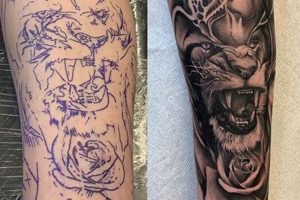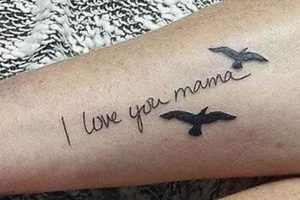Hand-poked tattoos, created by manually inserting ink into the skin with a needle, offer a distinct aesthetic characterized by subtle imperfections and a unique, often folk-art inspired, charm. These tattoos can range from simple linework and dotwork designs to more complex imagery, limited only by the artist’s skill and the client’s vision. Examples include minimalist symbols, floral motifs, script lettering, and geometric patterns.
This method allows for a high degree of control and precision, affording artists the ability to create delicate and intricate designs. The process, often perceived as less invasive than machine tattooing, may appeal to those seeking a more intimate and personalized experience. Historically, hand-poked tattoos hold significant cultural relevance in various indigenous communities worldwide, representing ritualistic practices, social status, and personal narratives. Today, the technique experiences a resurgence in popularity, driven by its unique aesthetic and connection to traditional methods.
Further exploration of this art form will encompass design considerations, hygiene practices, aftercare procedures, and the selection of reputable artists.
1. Placement
Placement significantly influences the overall impact and longevity of a hand-poked tattoo. Consideration of anatomical contours, visibility preferences, and potential pain levels is crucial. Areas with minimal movement and stretching, such as the outer arm or the outer thigh, often provide smoother surfaces for tattooing and tend to heal more predictably. Conversely, areas subject to frequent flexion or friction, like fingers and inner lips, may experience faster ink fading and blurring. A small, symbolic design on the wrist, for example, might be more prone to fading than a similar design placed on the shoulder blade. This is due to the wrist’s constant movement and exposure to environmental factors.
Choosing appropriate placement also requires careful consideration of pain tolerance. Areas with thinner skin and closer proximity to bone, such as ankles, elbows, or ribs, tend to be more sensitive. Conversely, areas with more muscle or fat padding, such as the outer thigh or upper arm, generally offer a more comfortable experience. A larger, more intricate design on the ribs, for example, might require multiple sessions and necessitate a higher pain tolerance compared to a smaller design on the calf muscle. Understanding these factors allows for informed decisions and a more positive tattooing experience.
Optimal placement enhances both the aesthetic appeal and the longevity of a hand-poked tattoo. Careful consideration of anatomical contours, movement, and potential pain levels contributes to a successful outcome. Consulting with experienced artists allows for personalized guidance, ensuring the chosen design complements the individual’s body and preferences. This collaborative approach ultimately results in a more meaningful and enduring piece of body art.
2. Size and Scale
Size and scale are critical design considerations for hand-poked tattoos. Appropriate scaling ensures the design’s clarity and longevity, while also influencing the overall aesthetic and the practicalities of the tattooing process.
- Detail Retention
Intricate details in smaller tattoos might blur or lose definition over time due to the nature of hand-poked application and natural skin changes. Larger designs allow for more spacing between elements, preserving intricate details and ensuring clarity as the tattoo ages. A small, highly detailed portrait, for example, might lose definition over time, whereas a larger rendition of the same portrait would retain its details more effectively.
- Session Length and Complexity
Larger designs inherently require more time and multiple sessions to complete. This impacts both the artist’s workload and the client’s commitment. A large, full-back piece, for instance, will require considerably more time and sessions compared to a small, minimalist symbol. This extended timeframe necessitates careful planning and consideration of healing times between sessions.
- Visual Impact and Proportion
The scale of a hand-poked tattoo should complement the chosen imagery and the body part on which it is placed. A large-scale design on a small area might appear overwhelming, while a small design on a large area could appear lost. A sprawling landscape scene, for example, would be better suited to a larger canvas like the back or thigh, whereas a small floral motif might be more appropriately scaled for the wrist or ankle.
- Healing and Aftercare
Larger tattoos, covering more skin area, require more diligent aftercare and may take longer to heal completely. This increased healing time necessitates greater attention to hygiene and aftercare practices to prevent infection and ensure optimal healing. A large, intricate piece, for example, requires more meticulous aftercare than a small, simple design, due to the larger surface area involved.
Careful consideration of size and scale ensures the longevity, clarity, and overall aesthetic success of a hand-poked tattoo. Balancing design complexity with appropriate scaling, considering the chosen imagery and placement, and factoring in the time commitment and aftercare requirements contribute to a well-executed and enduring piece of body art. Consulting with experienced artists facilitates informed decision-making regarding size and scale, ultimately enhancing the final result.
3. Design Simplicity
Design simplicity is a cornerstone of successful hand-poked tattoos. The method’s inherent limitations and unique aesthetic qualities lend themselves particularly well to minimalist designs. Simplicity enhances clarity, promotes efficient execution, and contributes to the longevity of the tattoo.
- Clarity and Definition
Simpler designs, characterized by clean lines and minimal detail, maintain their clarity over time. Intricate details in hand-poked tattoos can blur or merge due to the nature of the application and the skin’s natural aging process. A simple outline of a flower, for instance, will remain recognizable longer than a highly detailed, photorealistic depiction. This clarity is crucial for the tattoo’s visual impact and longevity.
- Efficient Execution and Healing
Simpler designs require fewer passes with the needle, reducing trauma to the skin and promoting faster healing. This efficiency benefits both the artist and the client, minimizing discomfort and reducing the overall time investment. A small, geometric design, for example, can be executed and healed more quickly than a large, complex piece. This efficiency is particularly relevant for hand-poked tattoos due to the manual nature of the process.
- Aesthetic Harmony with the Method
The inherent imperfections and subtle variations in hand-poked tattoos complement simpler designs, creating a unique, organic aesthetic. Highly detailed or realistic designs can clash with this aesthetic, losing their intended impact. Bold lines and simple shapes, however, harmonize with the method’s inherent qualities, enhancing the overall visual appeal. A minimalist line drawing of an animal, for instance, would likely complement the hand-poked aesthetic more effectively than a detailed, shaded rendering.
- Adaptability to Different Styles
Simplicity provides a versatile foundation for various hand-poked tattoo styles, from minimalist linework to dotwork and geometric patterns. This adaptability allows for creative expression within the constraints of the method. A series of simple dots, for example, can be arranged to create intricate patterns or representational imagery, showcasing the versatility of simple design elements within the hand-poked context.
Design simplicity in hand-poked tattoos contributes significantly to their clarity, longevity, and aesthetic appeal. By embracing minimalism and focusing on essential elements, artists can create enduring pieces that showcase the unique beauty of this traditional method. This focus on simplicity not only enhances the visual impact but also promotes efficient execution and healing, making it a key consideration for both artists and clients.
4. Linework and Shading
Linework and shading are fundamental elements in hand-poked tattoos, significantly influencing the final aesthetic and the overall impression. Skillful execution of these elements contributes to the depth, texture, and visual impact of the design. Understanding their interplay is crucial for both artists and clients seeking hand-poked tattoos.
- Line Weight and Consistency
Varying line weights creates visual interest and can be used to emphasize certain design elements or create the illusion of depth. Consistent linework requires practice and control, ensuring a clean and polished final result. Bold, consistent lines might define the outline of a geometric pattern, while finer lines could add delicate details within the design. Inconsistent or wobbly lines, however, can detract from the overall aesthetic, highlighting imperfections rather than intentional artistic choices.
- Shading Techniques: Dotwork and Stippling
Hand-poked shading often relies on techniques like dotwork and stippling, where varying densities of dots create gradients and textures. Dotwork uses consistent dot sizes to create shading, while stippling employs varying dot sizes and spacing for a more textured effect. These techniques offer a unique aesthetic distinct from machine shading, contributing to the characteristic hand-poked look. A dense cluster of dots can create a dark shadow, while sparsely placed dots create a lighter shade. These techniques allow for subtle gradations and intricate textural effects.
- Creating Depth and Dimension
Strategic placement of lines and shading creates depth and dimension within the tattoo. Careful consideration of light and shadow adds realism and visual interest, even in simple designs. Darker shading in recessed areas and lighter lines on protruding elements can create the illusion of three-dimensionality. This interplay of line and shade is crucial for bringing a design to life and giving it a sense of form and volume.
- Balancing Simplicity and Detail
While detailed shading can enhance complexity, maintaining a balance with simplicity is crucial for hand-poked tattoos. Overly complex shading can muddy the design and obscure the characteristic aesthetic of the hand-poked method. A minimalist design might benefit from subtle shading to enhance its form, while a more intricate design might require more extensive shading to achieve the desired level of detail. Striking the right balance ensures the tattoo remains clear and visually appealing.
Mastering linework and shading techniques is essential for creating compelling hand-poked tattoos. These elements contribute significantly to the overall aesthetic, depth, and longevity of the design. Careful consideration of line weight, shading techniques, and the interplay of light and shadow allows artists to create visually striking and enduring pieces that showcase the unique qualities of the hand-poked method. A well-executed hand-poked tattoo demonstrates a mastery of these fundamental elements, resulting in a piece of art that is both visually appealing and technically proficient.
5. Color Palette
Color palette selection significantly impacts the aesthetic and longevity of hand-poked tattoos. Careful consideration of ink properties, design complexity, and desired visual effects is crucial for achieving optimal results. Understanding the limitations and advantages of various color choices informs the creative process and ensures a successful outcome.
- Black Ink: A Classic Choice
Black ink remains a popular choice for hand-poked tattoos due to its density, durability, and historical significance. It provides bold, lasting lines and solid fills, well-suited to the method’s inherent aesthetic. Black ink also ages well, maintaining its clarity over time, making it a reliable choice for various designs, from simple linework to intricate tribal patterns. Its historical prevalence in traditional tattooing further adds to its appeal.
- Limited Palettes and Color Theory
Restricting the color palette, particularly in hand-poked tattoos, often enhances visual impact and simplifies the tattooing process. Applying color theory principles, such as complementary or analogous color schemes, creates harmonious and visually appealing results. A limited palette might consist of two or three carefully chosen colors that complement each other and the overall design. This approach allows for a focused aesthetic and avoids potential muddying or visual clutter.
- Challenges of Color Saturation and Longevity
Achieving vibrant color saturation in hand-poked tattoos can be challenging due to the manual application and the layering of ink. Certain colors, especially lighter shades, may fade more quickly than black ink. This requires careful consideration of colorfastness and the potential need for touch-ups over time. Understanding these limitations allows for realistic expectations and informed color choices.
- Color and Cultural Significance
In some cultures, specific colors hold symbolic meaning. Incorporating these culturally significant colors into a hand-poked tattoo can add depth and personal relevance. Researching and understanding these cultural associations is crucial for avoiding misinterpretations or unintentional cultural appropriation. Respectful consideration of cultural context enhances the meaning and significance of the tattoo.
The chosen color palette contributes significantly to the overall impact and longevity of a hand-poked tattoo. Careful consideration of ink properties, color theory principles, and cultural context informs the creative process and ensures a successful and meaningful result. Understanding the limitations and advantages of various color choices empowers both artists and clients to make informed decisions, resulting in a tattoo that is both aesthetically pleasing and personally resonant.
Tips for Hand-Poked Tattoos
Successful hand-poked tattoos require careful planning and execution. These tips offer guidance for achieving desirable outcomes and minimizing potential complications.
Tip 1: Research Thoroughly
Thorough research is crucial before committing to a hand-poked tattoo. Research includes design inspiration, reputable artists specializing in the method, and potential health risks. Examining portfolios helps determine an artist’s skill level and suitability for the desired aesthetic. Understanding potential complications, such as infections or allergic reactions, allows for informed decision-making.
Tip 2: Prioritize Hygiene
Maintaining stringent hygiene standards is paramount for safe hand-poking. Sterile needles, gloves, and a clean working environment are essential to prevent infections. Artists should adhere to proper sterilization protocols, and clients should confirm these practices before commencing the procedure. Neglecting hygiene can lead to serious health consequences.
Tip 3: Start Small and Simple
Beginning with a small, simple design allows for an assessment of pain tolerance and the healing process. Smaller tattoos also provide valuable experience and allow artists to refine their technique before undertaking larger, more complex pieces. A small, minimalist design represents a lower commitment than a large, intricate piece and offers a manageable introduction to hand-poked tattoos.
Tip 4: Practice Aftercare Diligently
Proper aftercare is crucial for optimal healing and ink retention. Keeping the tattoo clean, moisturized, and protected from sun exposure promotes healthy healing and minimizes the risk of infection or fading. Following artist instructions regarding aftercare procedures is essential for achieving the best possible results. Neglecting aftercare can compromise the tattoo’s appearance and longevity.
Tip 5: Communicate Effectively with the Artist
Open communication between the artist and the client is essential throughout the process. Discussing design preferences, placement, and potential concerns ensures a collaborative and positive experience. Clear communication helps establish realistic expectations and minimizes the potential for misunderstandings or dissatisfaction.
Tip 6: Respect the Healing Process
Hand-poked tattoos require time to heal fully. Avoiding picking or scratching the tattoo during the healing process is crucial for preventing scarring or ink loss. Patience is essential, as complete healing can take several weeks or even months, depending on the size and complexity of the tattoo. Rushing the healing process can compromise the final result.
Tip 7: Consider Touch-Ups
Hand-poked tattoos may require touch-ups over time, particularly with colored inks. Fading can occur due to various factors, including sun exposure and the skin’s natural exfoliation process. Planning for potential touch-ups ensures the tattoo’s longevity and maintains its desired appearance.
Following these tips contributes to a positive and successful hand-poked tattoo experience. Careful planning, research, and communication, combined with diligent aftercare, ensure optimal results and minimize potential complications.
Considering these elements allows for informed decisions and contributes to a fulfilling experience, resulting in a meaningful and well-executed piece of body art.
Frequently Asked Questions
This section addresses common inquiries regarding hand-poked tattoos, providing factual information to clarify potential concerns and misconceptions.
Question 1: Are hand-poked tattoos more painful than machine tattoos?
Pain perception varies among individuals. Generally, hand-poked tattoos are often described as less painful than machine tattoos, sometimes likened to a series of small pinpricks. The slower pace and less invasive nature of the technique may contribute to this perception.
Question 2: How long do hand-poked tattoos take to heal?
Healing time typically ranges from two to four weeks, depending on factors such as size, placement, and individual healing rates. Proper aftercare significantly influences healing time and overall outcome.
Question 3: Are hand-poked tattoos safe?
Hand-poked tattoos are safe when performed by trained artists adhering to strict hygiene protocols. Sterile needles, gloves, and a clean environment are crucial for preventing infections and complications. Thorough research and selection of a reputable artist are paramount.
Question 4: How long do hand-poked tattoos last?
Longevity is comparable to machine tattoos, lasting for many years with proper care. Factors influencing longevity include ink quality, placement, and sun exposure. Touch-ups may be necessary over time to maintain vibrancy and clarity.
Question 5: How much do hand-poked tattoos cost?
Pricing varies depending on factors such as size, complexity, artist experience, and geographic location. Generally, hand-poked tattoos may have a similar price range to machine tattoos, though smaller designs may be less expensive.
Question 6: Can all designs be created using the hand-poke method?
While many designs are achievable, certain highly detailed or photorealistic styles may be less suited to the hand-poked method. Simpler designs, bold lines, and limited color palettes often lend themselves well to this technique. Consulting with an experienced hand-poke artist helps determine design feasibility.
Understanding these fundamental aspects facilitates informed decision-making and ensures a positive experience for those considering hand-poked tattoos. Thorough research and open communication with experienced artists are essential for achieving desired outcomes.
Further exploration may include detailed artist portfolios, aftercare guidelines, and specific design considerations.
Conclusion
Exploration of hand-poked tattoo design necessitates careful consideration of placement, size and scale, design simplicity, linework and shading, and color palette. Each element contributes significantly to the final aesthetic, longevity, and overall success of the tattoo. Understanding these core aspects allows for informed decisions and facilitates a collaborative process between artist and client.
Hand-poked tattoos offer a unique aesthetic and a connection to a rich history of body art. This method allows for a high degree of artistic expression and personal meaning. By understanding the nuances of this technique and embracing its inherent limitations, individuals can make informed choices, resulting in meaningful and enduring body art.







